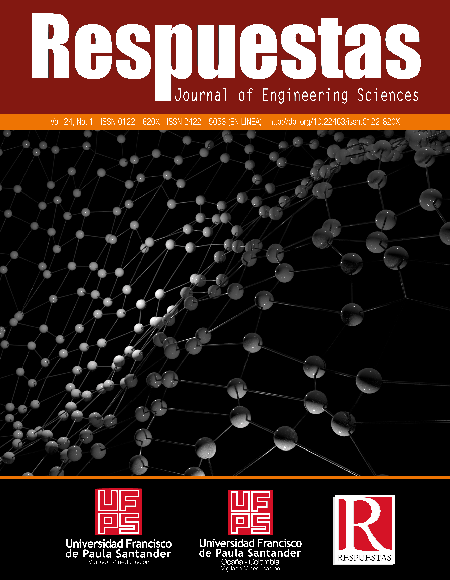Analysis of energy and major components in chromatographic signals for the diagnosis of prostate cancer
Análisis de la energía y de los principales componentes de las señales cromatográficas para el diagnóstico del cáncer de próstata
Main Article Content
The prostate exam is an early detection tool to prevent prostate cancer and the main diagnostic tools for obtaining signs are generally invasive. This article tries chromatographic signals from the urine of prostate cancer patients and control patients as a non-invasive examination proposal. For this purpose, methodologically, urine samples are taken, digitized in chromatograms, treated with mathematical techniques and classified. The mathematical techniques are time normalization, dead time elimination, baseline correction, noise elimination, and peak alignment. Classification techniques analyze energy, in the domain of time and frequency, and the main components in sedimentation graphs and scores. As a result, the chromatographic signal is characterized and identifies the characteristic curve that represents the signal of prostate cancer patients and control patients. The data structure shows a cluster distribution of 88.88% of the vectors for the control patients. In the case of prostate cancer patients, the distribution of data is in clusters around the area defined by control patients. This characterization demarcates signal classification regions to diagnose possible prostate cancer patients, validating the relationship between the chromatographic signal and cancer.
Downloads
Article Details
Á. Fajardo-Zapata and G. Jaimes-Monroy,“Conocimiento, percepción y disposición sobre el examen de próstata en hombres mayores de 40 años,” Investig. Orig., vol. 64, no. 2, pp. 223–228,2016.
D. Glujovsky, A. Bardach, S. García-Martí, D.Comandé, and A. Ciapponi, “PRM2 EROS: A New Software For Early Stage Of Systematic REVIEWS,”Value Heal., vol. 14, no. 7, p. A564, Nov. 2011.
I. Rivera et al., “Diseño de dispositivos para el diagnóstico de sarcopenia en miembro superior,”Memorias del Congr. Nac. Ing. Biomédica, vol. 2,no. 1, pp. 174–177, 2017.
L. Garrido-Martínez and R. I. González-Fernández, “Revista cubana de informática médica,”Rev. Cuba. Informática Médica, vol. 15, no. 2, pp.153–164, 2015.
E. Dugarte-Dugarte et al., “Algoritmo de bajo costo de procesamiento para la detección de potenciales tardíos ventriculares (PTV),” CLIC Conoc. Libr. y Licenciamiento, vol. 8, no. 15, pp.73–93, 2017.
P. A. Stack-Sánchez, G. Dorantes-Méndez, and A. R. M. Rodríguez, “Caracterización del temblor Parkinsoniano mediante dimensión fractal en señales de acelerometría,” Memorias del Congr. Nac. Ing.Biomédica, vol. 5, no. 1, pp. 190–193, Oct. 2018.
M. E. Bedoya-Vargas, J. C. Vásquez-Correa,and J. R. Orozco-Arroyave, “Time-frequency representations from inertial sensors to characterize the gait in Parkinson’s disease,” TecnoLógicas, vol.21, no. 43, pp. 53–69, Sep. 2018.
I. G. Bravo, P. A. S. Sánchez, G. D. Méndez, and A. R. M. Rodriguez, “Evaluación del movimiento a través de acelerometría en pacientes con enfermedad de parkinson,” Memorias del Congr. Nac. Ing.Biomédica, vol. 4, no. 1, pp. 138–141, Sep. 2017.
E. Payá-Bosch, “Desarrollo de un sistema de extracción avanzada de características en imagen histológica para la identificación automática del cáncer de próstata,” Universidad Politécnica de Valencia, 2017.
B. Zapote-Hernández, J. Cruz-Santiago,E. González-Vargas, and A. Jaramillo-Núñez,“Concordancia diagnóstica entre los métodos visual e informático en la detección de metástasis por gammagrafía ósea en cáncer de próstata,” An.Radiol. México, vol. 15, no. 2, pp. 111–119, 2016.
L. Hussain et al., “Prostate cancer detection using machine learning techniques by employing combination of features extracting strategies,”Cancer Biomarkers, vol. 21, no. 2, pp. 393–413,Feb. 2018.
J. Wang, C.-J. Wu, M.-L. Bao, J. Zhang, X.-N.Wang, and Y.-D. Zhang, “Machine learning-based analysis of MR radiomics can help to improve the diagnostic performance of PI-RADS v2 in clinically relevant prostate cancer,” Eur. Radiol., vol. 27, no.
, pp. 4082–4090, Oct. 2017.
B. Patiño-Domínguez, “Determinación de parámetros operacionales necesarios en el empaquetado de columnas de cromatografía,”Universidad Da Coruña, 2016.
R. Majors, Sample preparation fundamentals for chromatography. Canada: Agilent Technologies,2013.
J. Cazes, Encyclopedia of Chromatography, 3ra ed. New York, 2009.
A. Medina-Santiado, “Sistema de diagnóstico de señales biomédicas con redes neuronales artificiales,” Chiapas, 2015.
J. A. Navarro-Acosta and J. P. Nieto-González, “Detección y diagnóstico de fallas para la dinámica lateral de un automóvil utilizando máquinas de soporte vectorial multiclase,” Res. Comput. Sci., vol.73, pp. 167–179, 2014.
M. A. Melara-Estrada, “Introducción a la transformada Wavelet y la la teoría de análisis de señales,” Universidad de El Salvador, 2015.
A. Sheinker and M. B. Moldwin, “Magnetic anomaly detection (MAD) of ferromagnetic pipelines using principal component analysis (PCA),” Meas.Sci. Technol., vol. 27, no. 4, p. 045104, Apr. 2016.
Z. Chen, Q. Zhu, Y. C. Soh, and L. Zhang,“Robust Human Activity Recognition Using Smartphone Sensor via CT-PCA and Online SVM,”IEEE Trans. Ind. Informatics, 2017.
J. G. Rueda-Bayona, C. J. Elles-Pérez, E.H. Sánchez-Cotte, Á. L. González-Ariza, and G.D. Rivillas-Ospina, “Identificación de patrones de variabilidad climática a partir de análisis de componentes principales, Fourier y clúster k-medias,” Tecnura, vol. 20, no. 50, pp. 55–68, 2016.
P. Arroyo, I. Suárez, J. Lozano, J. Herrero, and P. Carmona, “Nariz electrónica personal para la detección de contaminantes en el aire,” Actas las XXXIX Jornadas Automática, pp. 894–899, 2018.
T. O’Haver, “A Pragmatic Introduction to Signal Processing with applications in scientific measurement,” University of Maryland at College Park, 2018.
F. Savorani, G. Tomasi, and S. B. Engelsen,“Alignment of 1D NMR Data using the iCoshift Tool: A Tutorial,” in Magnetic Resonance in Food Science: Food for Thought, 2013, pp. 14–24.
A. Kassambara, Practical guide to principal component methods in R : PCA, (M)CA, FAMD,MFA, HCPC, factoextra. STHDA, 2017.







